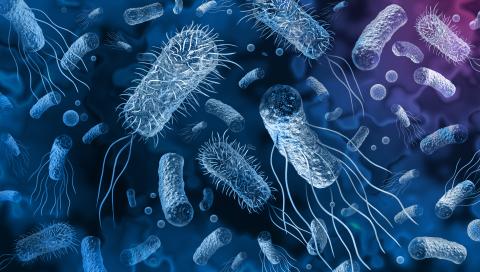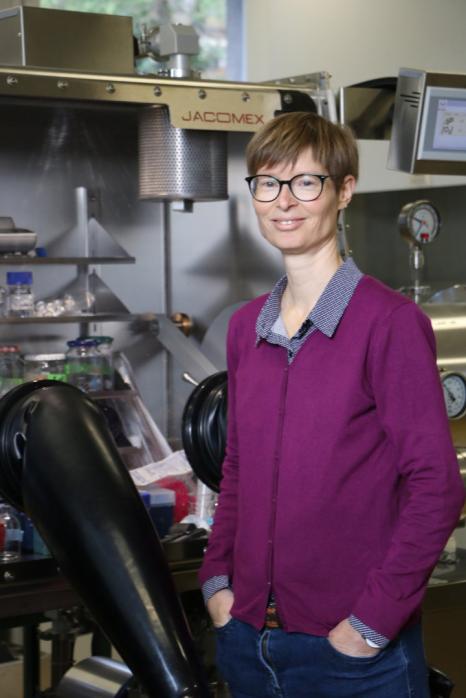
Tamara Basta-Le Berre: understanding the molecular mechanisms at work in archaea
Tamara Basta-Le Berre is a researcher in the Microbiology Department of the Institute for Integrative Cell Biology (I2BC - Univ. Paris-Saclay/ National Centre for Scientific Research, CNRS/ French Alternative Energies and Atomic Energy Commission, CEA) and lecturer in the vocational undergraduate degree in biotechnologies and bio-industries (LP3 BIB) and in the 1st year Master’s degree in biology-health at Université Paris-Saclay. A specialist in archaea, she focuses on the molecular mechanisms involved in nucleic acid metabolism and their evolution in these living organisms.
Inspired by the teachers she admired from an early age, Tamara Basta-Le Berre initially studied biology and chemistry in her native Croatia with the intention of teaching at secondary school. This path seemed clear, until Tamara Basta-Le Berre discovered the world of research. "During my studies, I had the opportunity to complete two internships in Germany, at the Institute of Microbiology in Stuttgart, where I discovered laboratory life, experimentation and research, which immediately fascinated me!" recalls the researcher. In 2000, she decided to continue her studies in Stuttgart, first for a Master's degree, then a PhD. "That's when I started working on the molecular mechanisms that enable certain soil bacteria to degrade pollutants of human origin." It was also during this time that she met her future husband, a Frenchman, and made another decisive choice: to move to France so as to reconcile her personal life with her passion for research.
The discovery of archaea
In 2005, she moved to Paris to undertake her postdoctoral research at a laboratory in the Pasteur Institute, working on viruses that infect archaea. "Having always worked on bacteria up until then, I began to take an interest in archaea—microorganisms that are morphologically similar to bacteria but are phylogenetically closer to eukaryotes—and the viruses with very particular morphologies that infect them," explains the researcher. She would dedicate three and a half years of research at the Pasteur Institute to this new area of focus, thanks to a grant she received. However, wanting to find a balance between her professional and family life, in 2008, she decided to leave Paris and join the Laboratory of Optics and Biosciences at the École Polytechnique, in Palaiseau (Essonne), to work on the discovery of new antibacterials targeting DNA metabolism. She then began looking for a lecturing position, which she secured in 2010 at the Université Paris-Sud. This position allowed her to join the laboratory of Patrick Forterre, the founder of archaea research in France.
Understanding the role of the KEOPS protein complex
"Shortly after I joined the laboratory, I was very fortunate to be assigned the co-supervision of a PhD candidate - Ludovic Perrochia - which immediately energised my research," says the researcher. Together, they sought to understand the role of a protein complex - called KEOPS - in the synthesis of a key transfer RNA modification, known as t6A. "Although we had known for 40 years that this modification was important for translation quality, we did not know how it was made in the cell. Our work was to link this t6A modification to the KEOPS complex. Notably, we reconstructed the entire reaction leading to the production of t6A at the level of transfer RNA and clarified the role of each component of the KEOPS complex in this reaction. This was a very important discovery as it served to link mutations in the genes coding for KEOPS to a serious genetic disease, the 'Galloway-Mowat syndrome'."
The shift to a new research topic
Buoyed by this very positive research dynamic and having obtained her Accreditation to Supervise Research (Habilitation à diriger des recherches or HDR) in 2014, Tamara Basta-Le Berre recruited a 3rd PhD candidate, Paul Vilain, with whom her career took a new turn. "Initially, I intended to continue my research on KEOPS, but Paul wanted to work on a subject more oriented towards evolutionary issues. So I thought, why not?" the researcher recalls. The initial experiment involved introducing the gene encoding a topoisomerase enzyme, known as gyrase, into an archaeon, whose function is to unpack DNA locally. "The idea was to mimic an evolutionary event that occurred millions of years ago, when an ancestral archaeon acquired the gyrase from a bacterium. We thought, however, that this experiment was doomed to failure, and that the cell of a modern archaeon would no longer be adapted to survive such an event. And yet, to our great surprise, the archaeon coped very well with the major change in DNA topology induced by the gyrase. I found this result very interesting, showing that, in archaea, the mechanism controlling DNA topology did not resemble what we know in bacteria. That's why, starting in 2018, I decided to focus all my research on this topic." These efforts earned her the Maurice Nicloux Prize from the French Society of Biochemistry and Molecular Biology in 2023.
The creation of a new research team
Following five years of research on this topic, which has already resulted in a number of publications, Tamara Basta-Le Berre is currently working on an ambitious research project, which will be carried out by a new team at the I2BC from March 2025. "Building a project born of a question of curiosity and structuring such a research programme is an exciting challenge," enthuses the researcher. To delve deeper into the question of DNA topology in archaea, the new DNA Topology in Archaea team will organise its research around four main axes: understanding the physiological role of topoisomerases found in archaea; gaining a better understanding of their emergence and evolution; understanding how DNA topology affects global chromosome folding; and understanding the contribution of DNA topology to the stress response of these microorganisms. "We are already collaborating with a laboratory at the Karolinska Institute in Sweden, which specialises in DNA topology in eukaryotes, on the ‘Physiological role’ axis. We're also working on setting up new collaborations, notably on the ‘Evolution’ axis with Violette da Cunha, a junior professor chair at Genoscope, on the ‘Stress resistance’ axis with a Bordeaux laboratory specialising in microfluidic systems that allow work at very high temperatures and pressures, and on the ‘Chromosome topology’ axis with a cross-disciplinary research programme at the I2BC," explains the researcher.
Curiosity, trust and dialogue as driving forces
From Stuttgart to Paris, from the Pasteur Institute to the Université Paris-Sud via the École Polytechnique: Tamara Basta-Le Berre's career path has been anything but linear. "Since I started in research, I've always been convinced that trust in our students and dialogue with our peers are our best tools for building great things," she explains. These are values that Tamara Basta-Le Berre shares with the educational team for the vocational undergraduate degree in biotechnology and bio-Industry, that she teaches. "Together, we have constantly proposed new educational approaches - skills-based thinking, flipped classroom and project-based teaching - to develop this degree, which is now built around a three-year course. I've always enjoyed working as part of a team, with complementary and motivated people and I'm convinced that their support has also contributed to the development of my research activity," concludes Tamara Basta-Le Berre.

